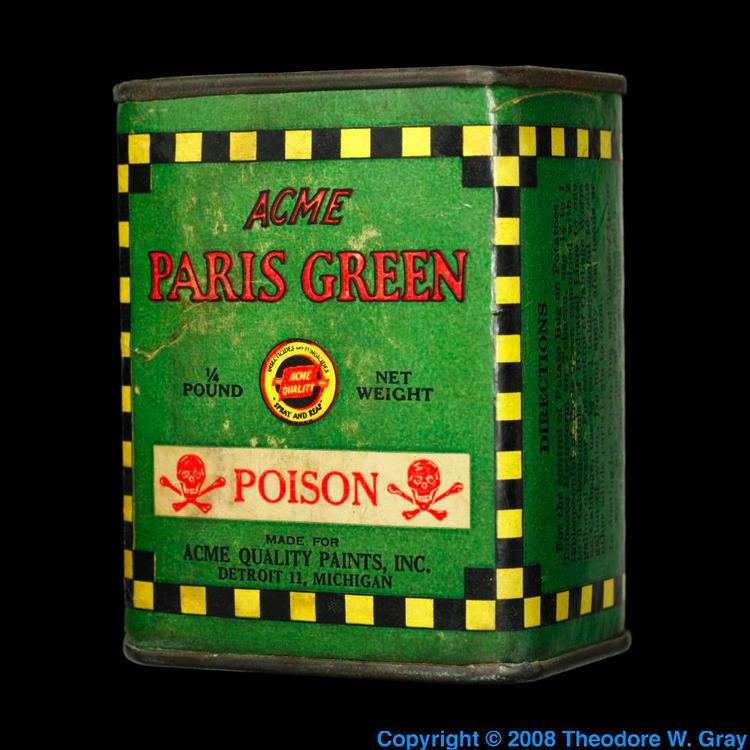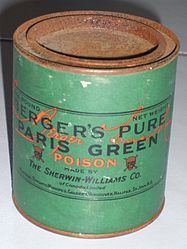Formula Cu(C2H3O2)2·3Cu(AsO2)2 | Molar mass 1,013.794 g/mol | |
 | ||
Appearance Emerald green crystalline powder | ||
Paris green (copper(II) acetate triarsenite or copper(II) acetoarsenite) is an inorganic compound. It is a highly toxic emerald-green crystalline powder that has been used as a rodenticide and insecticide, and also as a pigment, despite its toxicity. It is also used as a blue colorant for fireworks. The color of Paris green is said to range from a pale blue green when very finely ground, to a deeper green when coarsely ground.
Contents

Preparation
Paris green may be prepared by combining copper(II) acetate and arsenic trioxide.
Insecticide

Paris green was once used to kill rats in Parisian sewers, hence the common name. It was also used in America and elsewhere as an insecticide for produce such as apples, around 1900, where it was blended with lead arsenate. This toxic mixture is said "to have burned the trees and the grass around the trees". Paris green was heavily sprayed by airplane in Italy, Sardinia, and Corsica during 1944 and in Italy in 1945 to control malaria.
Pigment

Paris green, also called emerald green, was a popular pigment used in artists' paints by (among others) the English painter W. Turner, Impressionists such as Monet and Renoir and Post-Impressionists such as Gauguin, Cézanne and Van Gogh.
Related pigments
Similar natural compounds are the minerals chalcophyllite Cu
18Al
2(AsO
4)
3(SO
4)
3(OH)
27·36H
2O, conichalcite CaCu(AsO
4)(OH), cornubite Cu
5(AsO
4)
2(OH)
4·H
2O, cornwallite Cu
5(AsO
4)
2(OH)
4·H
2O, and liroconite Cu
2Al(AsO
4)(OH)
4·4H
2O. These vivid minerals range from greenish blue to slightly yellowish green.
Scheele's green is a chemically simpler, less brilliant, and less permanent, synthetic copper-arsenic pigment used for a rather short time before Paris green was first prepared, which was approximately 1814. It was popular as a wallpaper pigment and would degrade, with moisture and molds, to arsine gas. Paris green may have also been used in wallpaper to some extent and may have also degraded similarly. Both pigments were once used in printing ink formulations.
The ancient Romans used one of them, possibly conichalcite, as a green pigment. The Paris green paint used by the Impressionists is said to have been composed of relatively coarse particles. Later, the chemical was produced with increasingly small grinds and without carefully removing impurities; its permanence suffered. It is likely that it was ground more finely for use in watercolors and inks, too.
